
Wine Culture and Information since 2002 - Volume 23
 Wine Culture and Information since 2002 - Volume 23 |
|
Issue 244, November 2024 |
Contents |
|
|
More Wine Stories |
|
Last month's editorial has caught a certain amount of interest from consumers and producers, so much so that many have decided – in much greater number than usually happens – to send emails with their comments and thoughts on what I have written. With each incoming email, I expected to read reactions of disapproval from those who, perhaps hurt in their pride, legitimately wished to express their dissent. Of course there have been many emails disagreeing with my opinion, most of them from producers, however the majority – far more conspicuous than the minority – have expressed total agreement with what I have written. Among these, there are also many producers who, while not appreciating the fairytale and storytelling narrative of wine, find themselves having to suffer it in spite of themselves due to “unclear situations or conditions” and solely to satisfy a certain category of consumers and the commercial, cultural and social contexts to which they refer or belong to. I must also point out, with pleasure, that the majority of our readers have expressed comments of total agreement and approval, many also pointing out how in some cases certain narratives become ridiculous. Needless to say, I agree. Furthermore, I am pleased that I am not the only one who thinks that, very often, they exaggerate with this type of communication that excludes, in an all too evident way, wine, relegated to a marginal position compared to the exciting story of archaic fairies and extraordinary places blessed by a benevolent, unique and magical fate. To be fair, we have also received emails from our readers who appreciate this type of narration about wine, although they represent the minority. Even some producers, from what we read in their comments, seem to appreciate this communication expedient in presenting their wines, or rather, their company and production context. In last month's editorial, as a matter of fact, I would have liked to talk about another case in which disinhibited use is made of wine stories. Due to lack of space, I decided not to cover it on that occasion but – given the interest it has aroused, for better or for worse – I will do it in this month's editorial. I am referring to the vast category of restaurants, wine bars and wine shops, more generally, in places where wine is sold at retail. Perhaps it is the spread of storytellers, not least and as I have been able to personally observe, that certain consumers are more interested in wines with a story rather than the wine itself, often in restaurants, wine bars and wine shops this phenomenon is increasingly frequent. The narration and presentation of wines in these sales outlets sometimes borders on the ridiculous because of the way in which the amazing deeds of the producer or the winery are magnified, deliberately neglecting – perhaps to poorly conceal an embarrassing ignorance or lack of competence – the specific qualities of the wine. Tangible proof of how mistreated wine is in many restaurants can also be clearly seen in their wine lists. Vintages generally absent, denominations and names of wines approximate or incorrect, organization of categories carried out in a questionable and confusing way, names of producers combined with those of the wine, even incorrectly, sometimes omitted as well. The wine list is a working tool that undeniably facilitates and encourages sales, provided it is made and compiled in an appropriate and effective way. As I have already written in the past on this subject, I personally never order wine in restaurants where the wine list is clearly disorganized, approximate, confused or incomplete. Experience teaches me that the wine will be served with exactly the same disorder, approximation and confusion. Of course, not all restaurants are like this – there are obviously praiseworthy and admirable exceptions, not only in haute cuisine restaurants – but the majority, as far as I am concerned, have embarrassingly useless wine lists. Then there is the exciting category of restaurateurs, waiters and sommelier storytellers who usually perform on the improvised stage in front of the table of the unfortunate customer, especially when the wine list is not available or compiled in a whimsical way, not least, with extravagant creativity. Very often, the monologue begins without even asking what has been ordered from the kitchen or what one intends to order, starting to briefly list the wines available or to be proposed, mainly focusing the story on what the producer does, where he or she does it, the vision and philosophy of wine and, not least, the privilege he or she has had in life to live in such an enchanted place. If you try to ask specifically for information about the wines, the answer is often elusive and brief, then skillfully returning to the story of the producer, what he does, where he lives and how he lives, with such maniacal enthusiasm that you think it will surely also be revealed which political party he votes for, his religion and his zodiac sign. Maybe even his magical divine power to be able to speak to the birds, butterflies and lizards that live blissfully and happily in his enchanted vineyard. If you insist on the wine further, you see them change expressions and, with disappointment, they mumble something just to please you. If you then ask about the vintage of the wine, it is not uncommon to hear the answer “I don't know, I have to ask, I need to check, I'm not sure”. To this category, then, is added that of the winemaking talent scout who, triumphantly, tell how exciting it was to discover that producer that no one knew and that, by supreme and divine privilege, the customer at the table has the extraordinary luck of tasting his wines. It does not matter then if the wine is of an embarrassing mediocrity and full of faults: it is a very small and unknown producer, no less stoic defender of sacred winemaking – a staunch bulwark in a world of brutes and shady characters – underlining the unrepeatable luck of tasting, comfortably seated at the table, his masterpieces. Moreover, they invariably point out the fact that no other restaurant or wine shop offers the wines from that producer and, more often than not, tasting them makes you inexorably understand, in an all too simple way, why. Am I too polemical and sarcastic? Yes, certainly, and I know it all too well. But I am also convinced that listening to certain stories, or tales if you will, seems to me to be the appropriate way to comment. As I already wrote in the last month's editorial, when I want to immerse myself in the emotion of a story, I do it by reading a book or going to the theater. When I pour a wine into the glass, I want to listen to and taste that wine and that's it. The fact that its producer lives like a hermit, observing archaic lifestyles, having breakfast in the company of a jokester blue tit and in the evening, after dinner, playing cards with a grizzly bear, does not add or take anything away from the wine. Indeed, it is a crude attempt at emotional and psychological manipulation, an annoying expedient to turn the mind elsewhere and not where it should be, that is, on the wine in the glass. Above all, when this happens, I always end up having the same feeling, that is, that the storyteller on duty knows little or nothing about wine in general, hoping to hide his ignorance and incompetence with nice stories that tell everything except wine. Antonello Biancalana
|
||||
Contrasts of Collio Pinot Bianco and Oltrepò Pavese Pinot GrigioAmong the most famous and well-known grapes in the world, Pinot Bianco and Pinot Grigio make wines of notable elegance also thanks to their good enological versatility and their wide diffusion. |
|
Once upon a time there was Pinot Noir. It would seem like the appropriate beginning of a fairy tale and, in fact, talking about this extraordinary variety, for its history and its wines, the subject is certainly fabulous. Pinot Noir, in fact, is one of the oldest grapes known and, although its origins are still uncertain today, it is very likely that it is a domesticated vitis silvestris, that is, cultivated by man. Pinot Noir is also the “father” of other varieties and the two grapes that we will examine in our tasting are, in fact, genetic mutations of this magnificent red grape. Pinot Bianco and Pinot Grigio, in fact, are considered genetic mutations of Pinot Noir, the result of its well-known genetic instability. Furthermore, Pinot Bianco and Pinot Grigio also share with their illustrious parent the land of origin: Burgundy. However, it will not be in this extraordinary French wine land that Pinot Bianco and Pinot Grigio will give their best in terms of winemaking. It will be in Alsace and Italy that these two varieties will be widely used in winemaking, without forgetting – and no less important – that in past times, Pinot Bianco was frequently used in the production of Champagne, as a matter of fact, still today permitted by its production disciplinary. Pinot Bianco and Pinot Grigio arrived in Italy obtaining rapid success, no less, used for the production of crosses still widely cultivated today. It will be above all in the north of Italy that these two varieties will know their maximum success, so much so that they are present in DOC and DOCG wines of many northern regions of the country. Among these, Lombardy and Friuli-Venezia Giulia, regions in which the two grapes are widely cultivated and used for the production of wines, including sparkling wines, as in the case of Franciacorta which – in fact – provides for the use of Pinot Bianco.
|
|
Collio is one of the most important and main wine-growing areas of Friuli-Venezia Giulia, a great expression of the wines of the province of Gorizia and recognized as a Denominazione d'Origine Controllata (Denomination of Controlled Origin, DOC). With a surface area of 1500 hectares, Collio expresses a viticultural and enological richness and variety of primary interest. In this land, in fact, the number of grape varieties – white and red – is decidedly rich and diversified: its disciplinary allow and provides for the production of wines with as many as 16 different varieties, among these – of course – Pinot Bianco. Collio boasts a history and qualitative fame spanning centuries and already in the Middle Ages the wines of this territory were considered among the most valuable ones, sought-after and appreciated on the tables of nobles in most of Europe and Russia. In this territory, today mainly appreciated for its very elegant white wines, both the historic native varieties of the region and the so-called international ones are grown. The primary factor determining the quality and elegance of Collio wines is the constitution and composition of its soil, made up of friable marls and stratified sandstone blocks of Eocene origin that constituted the seabed that existed at the time. This type of formation – the Flysch – is locally called ponca or Flysch of Cormons. The lifting of these ancient seabeds gave rise to the Collio hills. This particular composition allows for excellent drainage, a characteristic that forces the vines to extend their roots deep into the subsoil in the essential search for water. In this territory, with its particular soil and suggestive hills, Pinot Bianco is capable of producing wines of marked finesse and elegance. The producers of Collio, with the aim of enhancing and preserving the finesse of Pinot Bianco, generally prefer the vinification in inert containers – the steel tank above all – even though there are also excellent wines fermented and aged in cask.
|
||||
|
Oltrepò Pavese is one of the main wine-growing areas of Lombardy, characterized by a significant ampelographic richness and like no other denomination in the region. The disciplinary of this territory, in fact, provides for the production of dozens of distinct wines, classified both by style and by variety. In addition, within this territory, specific denominations are also defined and solely dedicated to particular styles and grapes, among these, wines produced with Pinot Grigio. Oltrepò Pavese is among the primary wine-growing areas of Italy in which the pinot varieties are present, as a matter of fact, the primary one in which the majority of the country's Pinot Noir is grown and produced. Furthermore, in the vineyards of this territory there are many so-called international varieties and introduced a long time ago, also for experimental reasons and which then became an integral part of the viticultural and enological expression of Oltrepò Pavese. Among these, of course, there is Pinot Grigio, a variety that over time has assumed primary importance, so much so that it is recognized by a specific production disciplinary, Oltrepò Pavese Pinot Grigio, which provides for the still and sparkling styles. Thanks to the specific qualities of Pinot Grigio, with grapes characterized by a pink or reddish skin, the wines, in accordance with the production and enological choices, can sometimes show a faint copper color, a characteristic due to the contact of the skins with the must before fermentation. As regards wine making practices, the almost unique choice adopted for wines produced with Pinot Grigio involves the fermentation and aging in inert containers, in particular the steel tank. Although the disciplinary allows the use of wooden containers, this choice is mainly adopted with the aim of allowing a better expression of the organoleptic qualities of Pinot Grigio, in particular the crispness of the taste and the olfactory expression of flowers and fruits.
|
Before pouring the wines of our tasting into the glasses, we need to find the bottles of Collio Pinot Bianco and Oltrepò Pavese Pinot Grigio. In both cases, these are very popular wines, therefore virtually available in any wine shop. As is the case for almost all Italian denomination wines, also for Collio Pinot Bianco and Oltrepò Pavese Pinot Grigio, the respective production disciplinary require the use of the varieties indicated on the label with a minimum of 85%. Therefore, in choosing the two bottles, we will make sure that the composition is actually made up of the two varieties alone, a characteristic that is typical in the majority of cases. As regards the fermentation and aging, we will choose two wines that are completely produced using the steel tank. The two bottles, belonging to the most recent vintage, are poured into tasting glasses at a temperature of 10 °C (50 °F). We can now begin our tasting by contrast, therefore proceeding with the analysis of the appearance of Collio Pinot Bianco and Oltrepò Pavese Pinot Grigio. The first one we examine is the Friulian wine, therefore tilting the glass over a white surface, we observe the base in order to determine its color. We can see an intense and bright straw yellow, furthermore, placing an object in contrast between the glass and the white surface, it is observed a high transparency. Let's now observe the nuance of the wine, therefore we focus our attention towards the opening of the glass. Collio Pinot Bianco confirms the base color, that is, a straw yellow nuance. Let's move on to the evaluation of the appearance of Oltrepò Pavese Pinot Grigio, proceeding with the determination of the color and transparency. The Lombard wine shows an intense straw yellow, sometimes tending towards coppery yellow, a characteristic that is often found in all wines produced with this grape. The transparency is high and the nuance confirms the straw yellow color. The olfactory profiles of wines produced with Pinot Bianco and Pinot Grigio – although they share the same parent – differ substantially and evidently. In addition, environmental and viticultural factors must be considered – climate and level of ripeness at the time of harvest – as well as specific winemaking practices, a quality that can differ drastically especially for Pinot Grigio. It must in fact be considered that, depending on the style and the result which is wanted to obtain, producers can influence all the organoleptic qualities of Pinot Grigio according to the maceration of the must in the skins. In addition to determining a distinct olfactory and taste profile, the maceration in the skins leads to the production of white and ramato (coppery) styles, a characteristic that is clearly recognizable by their appearance. Generally speaking, wines produced with Pinot Bianco express a greater “freshness” than those made with Pinot Grigio, which are also characterized by freshness, although rounder. Let's resume our tasting by contrast and proceed with the evaluation of the olfactory profiles of the two wines, starting – as in the previous phase – with Collio Pinot Bianco. By holding the glass in vertical position and, without swirling it, we do the first smell in order to evaluate the opening, that is, the identification of the primary aromas of the wine. From the glass we perceive intense and clean sensations of apple, pear and hawthorn, often followed by plum. Let's now swirl the glass, an operation favoring the oxygenation of the wine, therefore the development of the olfactory qualities, and proceed with the second smell. The olfactory profile of Collio Pinot Bianco is completed with broom, pineapple, peach – often acacia – as well as sensations recalling citrus fruits such as citron and lemon. Let's now move on to the evaluation of the opening of Oltrepò Pavese Pinot Grigio, therefore, by holding the glass in vertical position, we do the first smell. We perceive intense and clean aromas of apple, peach, plum and broom. After swirling the glass, the olfactory profile is completed with pineapple, hazelnut, jasmine, lychee, chamomile, medlar, citron and, often, tangerine. Let's proceed with the evaluation of the gustatory profiles of the two wines, starting – as in the previous phases – with Collio Pinot Bianco. Let's take a sip of the Friulian wine, an operation allowing us the evaluation of its attack, that is, to examine the primary sensations perceived in the mouth. Collio Pinot Bianco is immediately appreciated for the marked crispness conferred by the acidity, often dominant and prominent compared to the rest, however well balanced by the effect of the alcohol. In the mouth, the flavors of apple, pear and plum are perceived, therefore with good correspondence with the nose. The wine definitely has a good body and is characterized by pleasing finesse and elegance. Let's now move on to the evaluation of the attack of Oltrepò Pavese Pinot Grigio, therefore let's take a sip of this wine. In the mouth, the Lombard wine can be appreciated for the pleasing crispness of the acidity, however – compared to Pinot Bianco – this sensation is decidedly rounder and less sharp. The wine finds its balance thanks to the effect of alcohol, also having good body and in the mouth can be perceived flavors of apple, peach, plum and pineapple. We have reached the end of this month's tasting by contrast, therefore we can proceed with the evaluation of the final sensations that the two wines leave in the mouth after swallowing. We will focus – in particular – on the taste-olfactory persistence. The finish of Collio Pinot Bianco is persistent and in the mouth we can continue to perceive, intense and clean, the flavors of apple, pear and plum as well as a sensation of pleasing acidity in which can be often recognized lemon and citron. The finish of Oltrepò Pavese Pinot Grigio is also persistent, leaving in the mouth intense and clean flavors of apple, pear, peach and pineapple, very often, a sensation recalling hazelnut. Compared to Collio Pinot Bianco, in the Oltrepò Pavese Pinot Grigio can be perceived a sensation of greater roundness, decidedly well supported by the pleasing crispness. Before concluding our tasting, let's proceed with a final smell from the two glasses, first Collio Pinot Bianco and then Oltrepò Pavese Pinot Grigio: the olfactory differences are still evident and very distinct.
|
||||||||
Wines of the Month |
|
|
|
Score legend Prices are to be considered as indicative. Prices may vary according to the country or the shop where wines are bought |

|
|
Friuli Colli Orientali Sauvignon Blanc Genesis 2021 |
|
| Valentino Butussi (Friuli-Venezia Giulia, Italy) | |
 Sauvignon Blanc Sauvignon Blanc | |
| Price: € 50.00 | Score: |
 Brilliant greenish yellow and nuances of greenish yellow, very
transparent. Brilliant greenish yellow and nuances of greenish yellow, very
transparent.
 Intense, clean, pleasing, refined and elegant, starts with hints of
pear, peach and elder flower followed by aromas of acacia, broom, apple,
lychee, pineapple, passion fruit, plum, nettle, box flower, fennel, tomato
leaf, sage and mineral. Intense, clean, pleasing, refined and elegant, starts with hints of
pear, peach and elder flower followed by aromas of acacia, broom, apple,
lychee, pineapple, passion fruit, plum, nettle, box flower, fennel, tomato
leaf, sage and mineral.
 Crisp attack and however balanced by alcohol, good body, intense
flavors, agreeable. Crisp attack and however balanced by alcohol, good body, intense
flavors, agreeable.
 Very persistent finish with long flavors of pear, peach and lychee. Very persistent finish with long flavors of pear, peach and lychee. Part of this wine ferments in cask. 12 months in bottle. Part of this wine ferments in cask. 12 months in bottle. |
|
 Pasta and risotto with vegetables and crustaceans, Sauteed crustaceans, Fried fish, Vegetable flans, Dairy products, Eggs Pasta and risotto with vegetables and crustaceans, Sauteed crustaceans, Fried fish, Vegetable flans, Dairy products, Eggs |
|
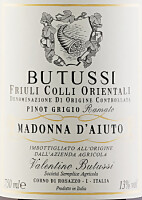
|
|
Friuli Colli Orientali Pinot Grigio Ramato Madonna d'Aiuto 2019 |
|
| Valentino Butussi (Friuli-Venezia Giulia, Italy) | |
 Pinot Grigio Pinot Grigio | |
| Price: € 55.00 | Score: |
 Deep salmon pink and nuances of cherry pink, moderate transparency. Deep salmon pink and nuances of cherry pink, moderate transparency. Intense, clean, pleasing, refined and elegant, starts with hints of
apple, plum and raspberry followed by aromas of hawthorn, jasmine, rose,
orange blossom, strawberry, cherry, pear, kiwi, pink grapefruit, ginger and
mineral. Intense, clean, pleasing, refined and elegant, starts with hints of
apple, plum and raspberry followed by aromas of hawthorn, jasmine, rose,
orange blossom, strawberry, cherry, pear, kiwi, pink grapefruit, ginger and
mineral.
 Crisp attack and however balanced by alcohol, full body, intense
flavors, pleasing roundness. Crisp attack and however balanced by alcohol, full body, intense
flavors, pleasing roundness.
 Very persistent finish with long flavors of apple, plum and raspberry. Very persistent finish with long flavors of apple, plum and raspberry. 10 months in cask, 12 months in bottle. 10 months in cask, 12 months in bottle. |
|
 Stuffed pasta with mushrooms, Stewed white meat, Stewed fish with mushrooms, Mushroom soups Stuffed pasta with mushrooms, Stewed white meat, Stewed fish with mushrooms, Mushroom soups |
|
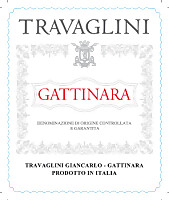
|
|
Gattinara 2020 |
|
| Travaglini (Piedmont, Italy) | |
 Nebbiolo Nebbiolo | |
| Price: € 27.00 | Score: |
 Brilliant ruby red and nuances of brick red, moderate transparency. Brilliant ruby red and nuances of brick red, moderate transparency. Intense, clean, pleasing, refined and elegant, starts with hints of
cherry, plum and dried violet followed by aromas of dried rose, raspberry,
strawberry, cocoa, tobacco, cinnamon, licorice, leather, graphite, vanilla
and menthol. Intense, clean, pleasing, refined and elegant, starts with hints of
cherry, plum and dried violet followed by aromas of dried rose, raspberry,
strawberry, cocoa, tobacco, cinnamon, licorice, leather, graphite, vanilla
and menthol.
 Properly tannic attack and however balanced by alcohol, full body,
intense flavors, pleasing crispness. Properly tannic attack and however balanced by alcohol, full body,
intense flavors, pleasing crispness.
 Persistent finish with flavors of cherry, plum and raspberry. Persistent finish with flavors of cherry, plum and raspberry. 30 months in cask. 30 months in cask. |
|
 Game, Roasted meat, Stewed meat with mushrooms, Broiled meat and barbecue, Cheese Game, Roasted meat, Stewed meat with mushrooms, Broiled meat and barbecue, Cheese |
|

|
|
Castelli di Jesi Verdicchio Riserva Classico Milletta 2021 |
|
| Sartarelli (Marches, Italy) | |
 Verdicchio Verdicchio | |
| Price: € 25.00 | Score: |
 Intense straw yellow and nuances of golden yellow, very transparent. Intense straw yellow and nuances of golden yellow, very transparent. Intense, clean, pleasing, refined and elegant, starts with hints of
apple, plum and hawthorn followed by aromas of broom, chamomile, pear,
citron, medlar, pineapple, anise, linden, thyme, flint and almond. Intense, clean, pleasing, refined and elegant, starts with hints of
apple, plum and hawthorn followed by aromas of broom, chamomile, pear,
citron, medlar, pineapple, anise, linden, thyme, flint and almond.
 Crisp attack and however balanced by alcohol, good body, intense
flavors, agreeable. Crisp attack and however balanced by alcohol, good body, intense
flavors, agreeable.
 Very persistent finish with long flavors of apple, plum and almond. Very persistent finish with long flavors of apple, plum and almond. Aged in steel tanks. Aged in steel tanks. |
|
 Pasta with fish, Broiled fish and crustaceans, Stewed fish with mushrooms, Stewed white meat, Dairy products Pasta with fish, Broiled fish and crustaceans, Stewed fish with mushrooms, Stewed white meat, Dairy products |
|
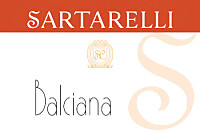
|
|
Verdicchio dei Castelli di Jesi Classico Superiore Balciana 2021 |
|
| Sartarelli (Marches, Italy) | |
 Verdicchio Verdicchio | |
| Price: € 35.00 | Score: |
 Brilliant straw yellow and nuances of straw yellow, very transparent. Brilliant straw yellow and nuances of straw yellow, very transparent. Intense, clean, pleasing, refined and elegant, starts with hints of
apple, plum and dried fig followed by aromas of hawthorn, chamomile, broom,
pear, dragée, citrus fruits, lychee, anise, linden, honey, almond and
flint. Intense, clean, pleasing, refined and elegant, starts with hints of
apple, plum and dried fig followed by aromas of hawthorn, chamomile, broom,
pear, dragée, citrus fruits, lychee, anise, linden, honey, almond and
flint.
 Crisp attack and however balanced by alcohol, full body, intense
flavors, pleasing roundness. Crisp attack and however balanced by alcohol, full body, intense
flavors, pleasing roundness.
 Very persistent finish with long flavors of apple, plum and dried
apricot. Very persistent finish with long flavors of apple, plum and dried
apricot.
 Aged in steel tanks. Aged in steel tanks. |
|
 Stuffed pasta with mushrooms, Roasted fish, Roasted white meat, Cheese Stuffed pasta with mushrooms, Roasted fish, Roasted white meat, Cheese |
|
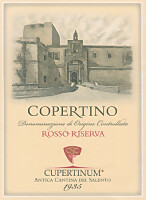
|
|
Copertino Rosso Riserva 2015 |
|
| Cupertinum (Apulia, Italy) | |
 Negroamaro Negroamaro | |
| Price: € 9.00 | Score: |
 Brilliant ruby red and nuances of brick red, moderate transparency. Brilliant ruby red and nuances of brick red, moderate transparency. Intense, clean, pleasing, refined and elegant, starts with hints of
plum, blackberry and dried violet followed by aromas of raspberry, black
cherry, blueberry, tamarind, carob, cocoa, tobacco, licorice, tar, leather
and menthol. Intense, clean, pleasing, refined and elegant, starts with hints of
plum, blackberry and dried violet followed by aromas of raspberry, black
cherry, blueberry, tamarind, carob, cocoa, tobacco, licorice, tar, leather
and menthol.
 Properly tannic attack and however balanced by alcohol, good body,
intense flavors, agreeable. Properly tannic attack and however balanced by alcohol, good body,
intense flavors, agreeable.
 Persistent finish with flavors of plum, blackberry and raspberry. Persistent finish with flavors of plum, blackberry and raspberry. Aged in steel and cement tanks. Aged in steel and cement tanks. |
|
 Broiled meat and barbecue, Roasted meat, Stewed meat with mushrooms, Cheese Broiled meat and barbecue, Roasted meat, Stewed meat with mushrooms, Cheese |
|
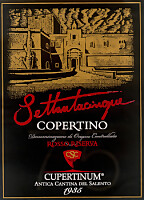
|
|
Copertino Rosso Riserva Settantacinque 2013 |
|
| Cupertinum (Apulia, Italy) | |
 Negroamaro Negroamaro | |
| Price: € 10.00 | Score: |
 Intense garnet red and nuances of garnet red, little transparency. Intense garnet red and nuances of garnet red, little transparency. Intense, clean, pleasing, refined and elegant, starts with hints of
plum jam, blackberry jam and dried violet followed by aromas of black
cherry jam, raspberry jam, carob, cocoa, tobacco, licorice, juniper, tar,
leather, graphite and menthol. Intense, clean, pleasing, refined and elegant, starts with hints of
plum jam, blackberry jam and dried violet followed by aromas of black
cherry jam, raspberry jam, carob, cocoa, tobacco, licorice, juniper, tar,
leather, graphite and menthol.
 Properly tannic attack and however balanced by alcohol, good body,
intense flavors, agreeable. Properly tannic attack and however balanced by alcohol, good body,
intense flavors, agreeable.
 Persistent finish with flavors of plum jam, blackberry jam and black
cherry jam. Persistent finish with flavors of plum jam, blackberry jam and black
cherry jam.
 Aged in steel and cement tanks. Aged in steel and cement tanks. |
|
 Broiled meat and barbecue, Roasted meat, Stewed meat with mushrooms, Cheese Broiled meat and barbecue, Roasted meat, Stewed meat with mushrooms, Cheese |
|

|
|
Chianti Classico Gran Selezione Il Picchio 2020 |
|
| Castello di Querceto (Tuscany, Italy) | |
 Sangiovese (95%), Colorino (5%) Sangiovese (95%), Colorino (5%) | |
| Price: € 30.00 | Score: |
 Intense ruby red and nuances of garnet red, little transparency. Intense ruby red and nuances of garnet red, little transparency. Intense, clean, pleasing, refined and elegant, starts with hints of
black cherry, plum and violet followed by aromas of rose, raspberry,
blueberry, tobacco, chocolate, mace, licorice, leather, vanilla and
menthol. Intense, clean, pleasing, refined and elegant, starts with hints of
black cherry, plum and violet followed by aromas of rose, raspberry,
blueberry, tobacco, chocolate, mace, licorice, leather, vanilla and
menthol.
 Properly tannic attack and however balanced by alcohol, good body,
intense flavors, pleasing crispness. Properly tannic attack and however balanced by alcohol, good body,
intense flavors, pleasing crispness.
 Persistent finish with flavors of black cherry, plum and raspberry. Persistent finish with flavors of black cherry, plum and raspberry. 12 months in cask and barrique, 6 months in bottle. 12 months in cask and barrique, 6 months in bottle. |
|
 Broiled meat and barbecue, Roasted meat, Stewed meat with mushrooms, Hard cheese Broiled meat and barbecue, Roasted meat, Stewed meat with mushrooms, Hard cheese |
|
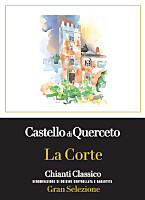
|
|
Chianti Classico Gran Selezione La Corte 2020 |
|
| Castello di Querceto (Tuscany, Italy) | |
 Sangiovese Sangiovese | |
| Price: € 32.00 | Score: |
 Intense ruby red and nuances of ruby red, little transparency. Intense ruby red and nuances of ruby red, little transparency. Intense, clean, pleasing, refined and elegant, starts with hints of
black cherry, plum and violet followed by aromas of rose, raspberry,
blueberry, arbutus berry, chocolate, face powder, tobacco, mace, thyme,
vanilla and menthol. Intense, clean, pleasing, refined and elegant, starts with hints of
black cherry, plum and violet followed by aromas of rose, raspberry,
blueberry, arbutus berry, chocolate, face powder, tobacco, mace, thyme,
vanilla and menthol.
 Properly tannic attack and however balanced by alcohol, good body,
intense flavors, pleasing crispness. Properly tannic attack and however balanced by alcohol, good body,
intense flavors, pleasing crispness.
 Persistent finish with flavors of black cherry, plum and raspberry. Persistent finish with flavors of black cherry, plum and raspberry. 12 months in barrique, 6 months in bottle. 12 months in barrique, 6 months in bottle. |
|
 Broiled meat and barbecue, Roasted meat, Stewed meat with mushrooms, Cheese Broiled meat and barbecue, Roasted meat, Stewed meat with mushrooms, Cheese |
|
News |
|
In this section are published news and information about events concerning the world of wine and food. Whoever is interested in publishing this kind of information can send us a mail to our address.
|
AquavitaeReview of Grappa, Distillates and Brandy |
|
|
||||||||||||
Wine Guide ParadeSummer 2024
|
| |||||||
Privacy Policy | |||||||


| Copyright © 2002-2025 Antonello Biancalana, DiWineTaste - All rights reserved |
| All rights reserved under international copyright conventions. No part of this publication and of this WEB site may be
reproduced or utilized in any form or by any means, electronic or mechanical, without permission in writing from DiWineTaste. |